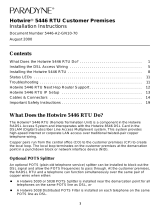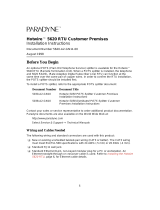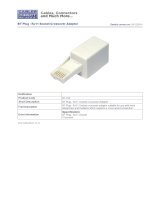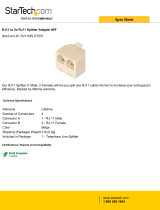Page is loading ...

1
Hotwire
®
6371 RADSL Router
Installation Instructions
Document Number 6371-A2-GN10-40
September 2001
Contents
Hotwire 6371 RADSL Router Overview ........................................................ 1
Product Documentation Online ..................................................................... 4
Getting Started .............................................................................................. 5
Installing DSL Access Wiring ........................................................................ 6
Connecting to the DSL Access Wiring .......................................................... 8
Installing the Hotwire 6371 RADSL Router ................................................... 9
Power-On ...................................................................................................... 14
Troubleshooting ............................................................................................. 15
Configuration Setup ...................................................................................... 16
RADSL Router Technical Specifications ....................................................... 22
Cables and Connectors ................................................................................ 17
Optional Wall Placement ............................................................................... 20
Important Safety Instructions ........................................................................ 23
Government Requirements ........................................................................... 24
Warranty, Sales, Service, and Training Information ...................................... 28
Hotwire 6371 RADSL Router Overview
The Hotwire
®
6371 RADSL (Rate Adaptive Digital Subscriber Line) Router is a
component in the Hotwire DSL Access system, which interoperates with Hotwire 8373,
8374, and 8510 RADSL line cards in the DSLAM (Digital Subscriber Line Access
Multiplexer) system.
The router operates as an IP router, connecting a DSL link to an Ethernet network to
provide high-speed Internet or corporate LAN access over traditional twisted-pair copper
telephone wiring. Copper pairs run from the central office to the customer premises to
create the local loop. The local loop terminates on the customer premises at the
demarcation point in a punchdown block or network interface device (NID).

2
NOTE:
In this document:
— End-user system is used to represent any host with an Ethernet connection.
— Service provider is used to represent any Internet Service Provider (ISP) or
remote Local Area Network (LAN) provider.
DSL Access with an Optional Hotwire 5030 POTS Splitter
An optional Hotwire 5030 POTS (plain old telephone service) Splitter can be installed to
block out the DSL signal and allow POTS frequencies to pass through. At the customer
premises, the DSL router and a telephone can function simultaneously over the same
pair of copper wires when a POTS splitter is installed near the demarcation point for all
telephones on the same POTS line as DSL.
When a Hotwire 5030 POTS Splitter is used at both ends of the local loop, wiring is
connected at the customer premises:
From the demarcation point to the CP POTS splitter, and
From the demarcation point to the DSL jack.
00-16571-01
Punchdown
Block or NID
DSL
Jack
Customer Premises (CP)
POTS/DSL
Ethernet
Crossover
Cable
Ethernet
Cable
or
Demarcation
Point
Local Loop
Hub
POTS
Splitter
DSL – Digital Subscriber Line POTS – Plain Old Telephone Service
NID – Network Interface Device
POTS
End-user
Systems
Service
Provider
DSL
Router
Central
Office
New Wiring Connections Existing Wiring (POTS)

3
DSL Access without a POTS Splitter
When the router is installed without a POTS splitter, the DSL line is used for data only;
it does not provide telephone services.
Phone Filters
For optimum performance, if the wiring for the router is also used for voice (POTS), a
phone filter should be installed on each voice line with a phone, modem, fax machine, or
other telecommunications device attached. One Hotwire phone filter can be used with
multiple telecommunications devices (for example, a phone and fax machine can be
supported using a single filter) if a multiple line adapter is used.
00-16570-02
Punchdown
Block or NID
DSL
Jack
DSL
Router
Customer Premises (CP)
DSL
Ethernet
Crossover
Cable
Ethernet
Cable
or
Central
Office
(CO)
Demarcation
Point
Local Loop
Hub
End-user
Systems
DSL – Digital Subscriber Line New Wiring Connections
NID – Network Interface Device
Service
Provider
01-17037
DSL
Router
Customer Premises (CP)
DSL/POTS
Ethernet
Crossover
Cable
Ethernet
Cable
or
Central
Office
(CO)
Local Loop
Hub
DSL – Digital Subscriber Lines
POTS – Plain Old Telephone Service
End-user
Systems
Network
Service
Provider
(NSP)
Demarcation
Point
Filter

4
There are two Hotwire phone filters that can be used with the RADSL Router:
Hotwire 6035 Universal Phone Filter is designed for use with a tabletop phone.
Hotwire 6040 Universal Wall Jack Phone Filter is designed for use with a
wall phone.
Product Documentation Online
Complete documentation for this product is available at
www.paradyne.com
.
Select
Library
→
Technical Manuals
→
Hotwire DSL Systems.
To order a paper copy of a Paradyne document:
Within the U.S.A., call 1-800-PARADYNE (1-800-727-2396)
Outside the U.S.A., call 1-727-530-8623
For more information about Hotwire DSL Routers, refer to the following document:
6371-A2-GB20
Hotwire DSL Routers User’s Guide
To install a POTS splitter or phone filter, refer to the appropriate document:
5030-A2-GN10
Hotwire 5030 POTS Splitter Customer Premises Installation
Instructions
6035-A2-GN11
Hotwire 6035 Universal Phone Filter Installation Instructions
6040-A2-GN11
Hotwire 6040 Universal Wall Jack Phone Filter Installation
Instructions
01-17038
RJ11
Wall Jack
RJ11
Wall
Jack
Customer
Premises (CP)
E
T
H
E
R
N
E
T
P
O
W
E
R
C
O
N
S
O
L
E
D
S
L
DSL
Router
6035
Phone Filter
6040
Wall Jack
Phone
Filter
Phone Filter

5
Getting Started
Before beginning your router’s installation, make sure that you have all the equipment
you will need.
Package Checklist
In addition to these instructions, verify that your package contains the following:
❑
Hotwire 6371 RADSL Router
❑
DSL interface cable with RJ11 modular plugs
❑
Power cord with power transformer
Wiring and Connectors You Will Need
The following wiring and standard connectors are used with this product:
❑
Standard RJ11 wall jack for the DSL cable.
❑
Multiple line adapter if a telephone and router are connected in the same location.
❑
DSL wiring: Unshielded twisted-pair wiring (CAT3, or better). The CAT3 wiring must
meet EIA/TIA-568 specifications, with 24 AWG (.5 mm) or 26 AWG (.4 mm).
❑
Ethernet wiring: Shielded twisted-pair wiring (CAT5, or better). The CAT5 wiring
must meet EIA/TIA-568 specifications, with 24 AWG (.5 mm) or 26 AWG (.4 mm).
A straight-through or crossover Ethernet cable is used.
Refer to procedures in
Installing the Hotwire 6371 RADSL Router
on page 9 to install
cables.
Optional Console Cable and Adapter
The Hotwire 6371 RADSL Router is typically configured remotely by the service
provider. The following optional cable and adapters are only used to configure the router
locally:
❑
Console cable: Straight-through cable with 8-pin non-keyed modular plugs
(Part No. 035-0276-1431)
❑
Console adapter:
— 8-pin modular-to-DB9 adapter plug (Part No. 002-0093-0031), or
— A configurable DB9-to-RJ45 adapter, wired as shown in
8-Pin Modular to DB9
Adapter Plug
on page 19.

6
Installing DSL Access Wiring
The local loop terminates at the punchdown block or NID. Wiring must be connected
from the customer premises side of the punchdown block or NID to an RJ11 jack.
Typically, the punchdown block is installed in commercial locations and the NID is
installed in residential locations.
Procedure
1.
Access the punchdown block or NID.
2.
Disconnect the DSL access pair from the local loop.
WA R N I NG :
!
Do not continue unless the DSL access line from the local loop has been
disconnected at the NID or punchdown block. Refer to
Important Safety
Instructions
on page 23.
The following example shows a punchdown block without POTS.
ABCD
DSL
Access
from Local
Loop
Wiring to
DSL Jack
Bridge Clip
Punchdown Block
00-15348-01
Demarcation Point
Customer Premises

7
3.
Locate the DSL pair of T1/R1 connectors on the customer premises side of the NID
or punchdown block. Attach the wiring that will be connected to the DSL jack.
The following example shows a NID without a POTS splitter. It includes an existing
POTS pair, and a second DSL pair is installed for DSL access.
DSL/POTS
Access from
Local Loop
Wiring to
DSL Jack
Telephone Network Interface Device (NID)
Ground
Tip
T1
(Green)
Ring
R1
(Red)
00-15438-02
Existing POTS
Wiring to
Telephone
Demarcation Point
Customer Premises
DSL Pair
POTS Pair

8
Connecting to the DSL Access Wiring
The Hotwire 6371 RADSL Router connects to the local loop via wiring from the
demarcation point to an RJ11 wall jack. The DSL twisted-pair wiring from the local loop
terminates at a new or existing wall jack. It may be necessary to install a standard single
RJ11 jack or replace a single jack with a double RJ11 jack.
Procedure
1.
Wiring can be run from the
punchdown block or NID to
a new or existing wall jack.
Match the pair colors on both
ends.
2.
Label the DSL jack.
3.
Reconnect the DSL access
pair at the punchdown block
or NID. Tighten both terminal
screws with a flat-blade
screwdriver.
The RJ11 6-pin jack uses the two center pins. For pin assignments, refer to
Cables and
Connectors
on page 17.
00-16567-01
DSL
RJ11
Jack
Central
Office
Punchdown
Block or NID
Customer Premises
POTS/DSL
Local Loop
Demarcation Point
DSL
Twisted-pair
Wiring
DSL
Router
97-15300a
RJ11 Wall Jack
or

9
Installing the Hotwire 6371 RADSL Router
Place the RADSL router on a flat surface, with clearance for the rear connectors. For
router cable pin assignments, refer to
Cables and Connectors
on page 17.
Connecting the DSL Line in a Home Environment (Phone and Router in
the Same Location)
For the DSL connection, use the supplied RJ11 6-pin cable. You will also need a multiple
line adapter and a filter (see
Phone Filters
on page 3).
Procedure
1.
Insert a multiple line adapter into the wall jack.
2.
Insert one end of the cable into the
DSL
jack on the router.
3.
Insert the other end of the cable into one of the jacks (
Line 1
or
Line 2
) on the
multiple line adapter.
4.
Insert the line cord from the
LINE
jack on the filter into the empty jack on the
multiple line adapter.
5.
Insert the phone line cord from the phone into the
PHONE
jack on the filter.
POW
ER
CONSOLE
DSL
ETHERNET
01-17018
LINE
PHO
N
E
6371 RADSL Router
Multiple
Line
Adapter
Filter

10
Connecting the DSL Line in All Other Environments
Use the supplied RJ11 6-pin cable for the DSL connection.
Procedure
1.
Insert one end of the cable into the
DSL
jack on the router.
2.
Insert the other end of the cable into the wall jack.
POW
ER
CONSOLE
DSL
ETHERNET
00-16509-01
DSL
Jack
6371 RADSL Router

11
Connecting the Ethernet Cable
Use an 8-pin Ethernet straight-through or crossover cable for the Ethernet connection.
Procedure
To connect an Ethernet Hub using a straight-through cable:
— Insert one end of the straight-through cable into the
ETHERNET
jack on the
router and connect the other end to an Ethernet hub. Do not connect it to the
hub’s optional Uplink connection; the Uplink connection requires an Ethernet
crossover cable. To support multiple end-user systems, refer to
Increasing the
Number of End-User Systems
on page 16.
To connect a PC using a crossover cable:
— Insert one end of the crossover cable into the
ETHERNET
jack on the router
and connect the other end of the cable to a PC with an Ethernet Network
Interface Card (NIC) installed.
01-16506-02
Ethernet
Line
POWER
CONSOLE
DSL
ETHERNET
Ethernet
Hub
Ethernet
Straight-through
Cable
8
7
6
5
4
3
2
1
6371 RADSL Router
01-16507-02
PC with Ethernet
Network Interface
Card (NIC)
Ethernet
Line
Ethernet
Crossover
Cable
POWER
CONSOLE
DSL
ETHERNET
6371 RADSL Router

12
Connecting to a VT100 Terminal or PC (Optional)
The Console port acts as a DCE and uses an 8-pin straight-through cable for the
connection to a VT100-compatible terminal or a PC running a terminal emulation
program. It is an optional connection that is only used for local configuration of the
router.
To set up the VT100 terminal or PC for local configuration and to access the router, refer
to
Configuration Setup
and
Accessing the Router
on page 16.
Procedure
1.
Connect a DB9 adapter to the PC.
2.
Insert one end of the cable into the DB9 adapter for the serial port of the VT100
terminal or PC.
3.
lnsert the other end of the cable into the
CONSOLE
jack on the router.
VT100 Terminal
or PC
(9-pin Adapter)
01-16505-02
Console
Serial Line
POWER
CONSOLE
DSL
ETHERNET
6371 RADSL Router

13
Connecting Power
Procedure
1.
Insert the supplied power cord’s round end into the
POWER
jack on the router.
2.
Plug the transformer into an AC outlet.
Installation of the hardware is now complete. When the power cord is installed, the
router goes through a power-on self-test.
POWER
CONSOLE
DSL
ETHERNET
01-16508-03
or
18 VDC
800 MA
Transformer
Power
Jack
6371 RADSL Router

14
Power-On
When power is applied, the router performs self-diagnostics and the PWR LED is on.
The self-diagnostics includes a power-on self-test. During the power-on self-test, all of
the LEDs turn on for one second.
Status LEDs
After a successful self-test, the LEDs should appear as indicated in
BOLD
in the
Condition column below. Refer to
Troubleshooting
on page 15 for LED indications
requiring action.
LED Condition Status
PWR
ON
The router has power.
ALM Blinking
ON
OFF
A firmware download is in progress. The TST LED is also
on during a download.
An alarm condition exists.
No alarms have been detected by the router.
TST ON
OFF
The TST LED is on during the power-on self-test, during a
test initiated by the service provider, and during a firmware
download.
No tests are active.
DSL Blinking
ON
OFF
The router is establishing the active DSL link. The LED
blinks on and off about five times per second.
The DSL link is ready to transmit and receive data.
No DSL link has been established.
ETHERNET
ON
OFF
The Ethernet connection is active.
No Ethernet device is detected.
TST
DSL
ETHERNET
ALMPWR
00-16502-01
Power – green
Alarm – red
Test – yellow
Digital Subscriber Line – green
Ethernet Link – green
6371
Hotwire 6371
Rate Adaptive
DSL Router

15
Troubleshooting
LED Symptom Action
All LEDs are on. If the LEDs remain on for more than ten minutes, the router is
not functional. Contact the service provider.
ALM LED remains on. The power-on self-test may have failed. Unplug the router
and reapply power. If the alarm LED is still on, contact the
service provider.
ALM and TST LEDs
are blinking.
A firmware download may be in progress. If a firmware
download is not in progress, or if the LEDs continue blinking
for more than ten minutes, contact the service provider.
DSL LED is off. Verify that the DSL cable is securely installed at both ends. If
the problem continues, contact the service provider.
DSL LED continues
to blink after the
power-on self-test.
The router is attempting to establish the DSL link or adjusting
the DSL line rate due to line conditions. If the DSL LED
continues to blink for more than ten minutes, contact the
service provider.
DSL LED is on, but
no data is being
transmitted.
The DSL link has been established, but data is not being
transmitted. Verify the Ethernet connection at both ends. If
the problem persists, contact the service provider.
DSL and Ethernet
LEDs are on, but
no data is being
transmitted.
Both the DSL and Ethernet links have been established, but
data is not being transmitted. If the problem continues,
contact the service provider.
Ethernet LED is off. Verify that the Ethernet cable is securely installed at both
ends, and at least one PC is connected and powered on.
Verify that the correct straight-through or crossover cable is
installed. Refer to
Connecting the Ethernet Cable
on page 11.
PWR LED is off. Check that the power cord is securely installed on both ends.
If no LEDs are on, the power supply may be defective. Test
the outlet to verify power.
If other LEDs are on, the PWR LED may be burned out.
Unplug the unit and reapply power; watch all LEDs during the
power-on self-test to verify that the PWR LED is functioning. If
the problem persists, contact the service provider.
TST LED is on. A test initiated by the service provider may be active. Wait ten
minutes. If the TST LED does not go off, contact the service
provider.

16
Configuration Setup
Connection to a VT100-compatible terminal or a PC running terminal emulation is
optional. It is used to configure the router locally, rather than the service provider
configuring the router remotely. Refer to
Connecting to a VT100 Terminal or PC
(Optional)
on page 12 to connect the router to a terminal or PC.
For local configuration, verify the following terminal or PC settings:
Data rate is set to 19.2 Kbps (19200 bps).
Character length is set to 8.
Parity is set to None.
Stop bits is set to 1.
Flow control is set to Off or None.
Accessing the Router
When the local console connection is first established, access control to the RADSL
router displays an initial prompt of
Login>
.
Procedure
1.
At the initial prompt of
Login>
, enter the factory default Login ID of
paradyne
.
2.
At the
password>
prompt, enter the factory default Password of
abc123
.
3.
At the next prompt for System ID, the factory default is
CUSTOMER>
.
Optionally, enter
show system
to display hardware/firmware information and
Selftest Results.
Refer to the
Hotwire DSL Routers User’s Guide
for configuration settings and command
line entries.
Increasing the Number of End-User Systems
The router can support differing numbers of end-user systems, depending upon the
functions that are enabled and traffic loading. Typical configurations provide support for
up to 32, 64, or 256 hosts (end-user systems).
An Ethernet crossover cable is used when a single PC is connected to the router. To
increase the number of PCs, connect all PCs to an Ethernet hub using a straight-
through cable. Increase the number of end-user systems by using subnets that utilize
static addressing, or by using a default gateway connection.
Refer to
Connecting the Ethernet Cable
on page 11 to connect the router to multiple
end-user systems or a single PC.

17
Cables and Connectors
This section is reference information.
Use a CAT3, or better, cable for the DSL line.
The DSL interface uses a 6-pin, non-keyed
modular plug.
RJ11 6-Pin Connector
Pin # Function
1 & 2 Not used
3DSL Ring
4DSL Tip
5 & 6 Not used
98-15304-01
6-Pin
RJ11 Plug
DSL
Cable
Pin #1
Pin #6

18
The Ethernet interface connector uses an 8-pin, non-keyed modular plug. Use
shielded twisted-pair CAT5, or better, cables.
— To connect the router to an Ethernet hub, use a straight-through connection.
8-Pin Straight-through Connection
– or –
— To connect the router to a PC with an Ethernet NIC card, use an Ethernet
crossover cable.
Pin # Function
1 10/100BaseT TX D+
2 10/100BaseT TX D–
3 10/100BaseT RX D+
4 & 5 Not used
6 10/100BaseT RX D–
7 & 8 Not used
98-16055a
8-Pin
Plug
Ethernet
Cable
Pin #1
Pin #8
10/100BaseT TX D+
10/100BaseT TX D–
10/100BaseT RX D+
Not Used
Not Used
10/100BaseT RX D–
Not Used
Not Used
1
2
3
4
5
6
7
8
1
2
3
4
5
6
7
8
10/100BaseT TX D+
10/100BaseT TX D–
10/100BaseT RX D+
Not Used
Not Used
10/100BaseT RX D–
Not Used
Not Used
Function Pin # FunctionPin #
8-Pin Ethernet Crossover Cable
99-16518
Pin #1/2 = Orange/White
Twisted Pair
Pin #3/6 = Blue/White
Twisted Pair

19
The Console connector uses 8-pin, non-keyed modular plugs and a DB9 adapter.
RJ45 8-Pin Connector
8-Pin Modular to DB9 Adapter Plug
Pin # Circuit Direction
1 Not used —
2 DTR Input to
Console port
3 TXD Input
4 & 5 Signal Ground —
6RXD Output
7DSR Output
8 Not used —
Modular
Pin # Circuit
DB9
Pin #
1RTS 7
2DTR 4
3TXD 3
4 & 5 Signal Ground 5
6RXD 2
7DSR 6
8CTS 8
97-15678
8-Pin
Plug
Console Port
Cable
Pin #1
Pin #8
98-16050
DB9
to RJ45

20
Optional Wall Placement
The Hotwire 6371 RADSL Router is designed for tabletop placement. The RADSL router
can also be mounted on a wall.
To mount the RADSL router, you will need:
❑
Three #6 pan-head screws with anchors (for example, molly bolts, plastic or lead
anchors)
❑
Drill, and the correct size drill bit for the anchors
❑
Screwdriver
A template with the dimensions for the three screws is provided. See
RADSL Router
Hardware Template
on page 21.
Procedure
To mount the RADSL router:
1.
Drill the correct size hole for the anchors and install them. Use the template to
gauge their placement.
2.
Screw the pan-head screws into the installed anchors. Do not make them flush with
the wall. Leave enough clearance to hang the router housing from the screws.
Wall
Fasteners
99-16170-02
/












